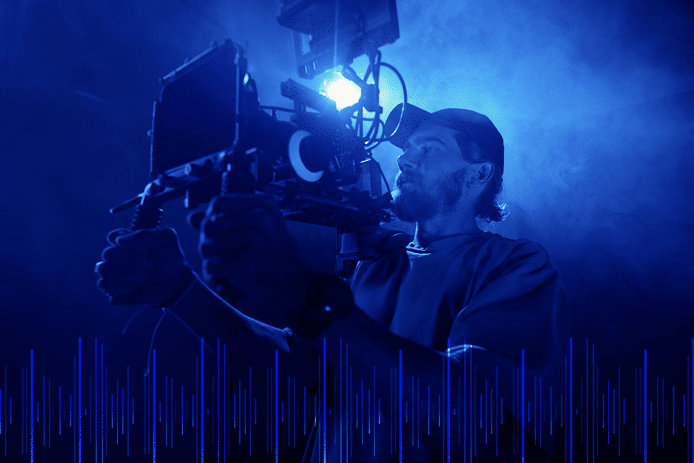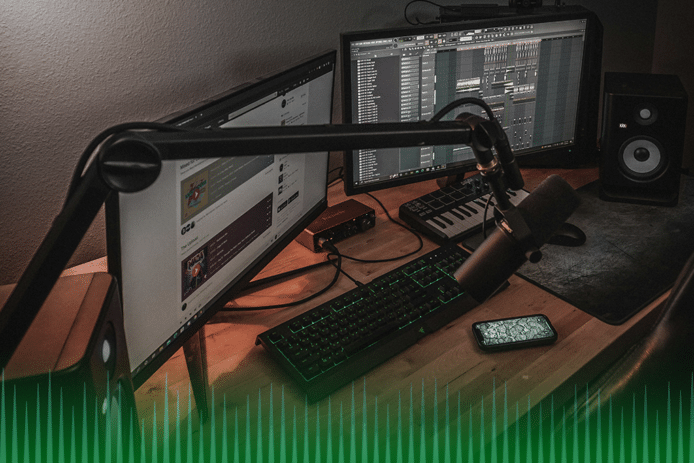Sonix is an automated transcription service. We transcribe audio and video files for storytellers all over the world. We are not associated with the Set Sail podcast. Making transcripts available for listeners and those that are hearing-impaired is just something we like to do. If you are interested in automated transcription, click here for 30 free minutes.
To listen and watch the transcript playback in real-time ?, just click the player below.
Full Transcript by Sonix: Best USB Microphones For Podcasting – Set Sail Podcast
Ross: Hey and welcome to Episode 5 of the Set Sail podcast. My name is Ross Kaplan Wynn and I'm glad you could join me today.
Ross: So today we we're going to talk about microphones specifically we're going to talk about USB microphones and worry about the other types in a future episode. And for USB the microphones what's great about them is that they're really easy to use compatible with literally every computer.
Ross: So you just plug them in and make sure that you have selected it as your input device in your computer and then you can open up any program you want. Garage Band or Audacity or Audition. There's a million million other programs if you if you want.
Ross: And start recording and it's really so that simple. You'll want to make sure that you have adjusted the input settings so the gain levels don't peek into the red. You know so you don't you don't want your voice to be cut off of you if you end up talking too loudly.
Ross: And besides that yeah there really is a use and there's really only a handful of quality USB microphones that that are recommended for for podcasting and recording recording your audio or your voice. Sure there's a bunch of other like kind of cheaper USB mics that work fine for Skype calls and you know business kind of meeting stuff.
Ross: But you probably want a little just a tiny bit higher quality one for podcasting but that doesn't mean they need to spend a ton. And all of USB microphones as far as I'm aware that are out there are all under 200 dollars.
Ross: And most are actually under under about 150 and some are a lot less closer to the 50 dollar range. So let's let's dive into it here and I'll highlight some of the best.
Ross: So the first one is the Blue Yeti and this one is extremely popular just because so many people use it and it has a ton of cool features so for one it has a headphone jack which is really important and actually that's one thing I want to recommend.
Ross: If you get a USB mic look for one that has a headphone jack so that you can monitor your audio without any delay. So if you plug in your headphone jack into your computer separate from your microphone there can be a slight a slight delay until you hear an echo as a recording and it just it doesn't it doesn't make it easy to listen to and or makes it difficult to record.
Ross: So that's one feature that I use strongly suggest looking at over over most of the others for USB mics and so that the Blue Yeti has four different settings on it. It has for how it picks up sound so it has cardiod which is a front facing nut's like your standard vocal recording setting.
Ross: It has omni directional which means the records are picks up sound equally from all sides which is great for that like a conference table or if you have a group of people kind of sitting around. That's an option.
Ross: It has a left and right option so it's just kind of stereo recording and it has bi directional which is front and back. So if you're doing an in person interview and you only have the Blue Yeti mic that would be a good option to use that.
Ross: And place it equally spaced in between you and then it should get both of your voices without picking up sounds from the side. So it's kind of cool that it has all those options. If you're going to use them and that's the the big if. The Blue Yeti was my first mic that I got and I thought oh sure I'll use all these features but I've only ever used it in the cardiod kind of a front facing setting.
Ross: So just something to think about because you do pay a little bit extra for that feature and then it also has gain control so you can control how sensitive the microphone is which is really cool because you don't have to set that in your software.
Ross: So that's a nice feature and then also has a volume control for your headphone right onboard so you can set that appropriately. And lastly it has a mute button which is really cool that not a lot of the not the other USB mics don't have.
Ross: So you can you can get mute mic or you know if you're need to cough or if you just want to make sure it's not recording. You can hit that button and it has a nice red light that that flashes when it's muted.
Ross: And so Blue actually discounts this mic a few times a year. So I've got it. Normally it's around 120 130 dollars but during Amazon Prime Day Black Friday Cyber Monday those type of special holiday sale days. I have found it for 80 to 90 dollars so just if you don't need it right away those are great times to get it.
Ross: But either way it's a it's an awesome deal for for the price. And they offer it in like 10 different colors. So there's black silver platinum white blue gray say white a different kind of white satin reds slate. So a bunch of stuff.
Ross: And then they also have a Yeti Pro model that includes the USB connection but it also includes an XLR connection so you can hook it up to a USB interface or mixer. And kind of gives you a lot more flexibility but that one comes at a higher higher cost.
Ross: So just something to be aware of that you have another option there. And I guess the only downside with the Yeti is that it's a it's a really large microphone. Because it has to have the audio digital to analog converter built in. And has all those different settings and a headphone amp and all the stuff.
Ross: So it's big and heavy which means that you need if you want to hook it up to boom arm or stand you'll need a really solid sturdy mic stand in order to use it with the Yeti. And especially if you add on there their Blue Radius 2 shock mount. That one is pretty heavy as well so this the weight starts to add add up and it will it will cripple some of the smaller boom arms just something to be aware of.
Ross: I personally use the Heil PL2T boom arm and it can hold it just fine. So but that one costs around 100 dollars. And I think the Rode has one as well that's a comparable price and quality. I would try to avoid some of the some of the knockoff options if you're going with the Blue Yeti.
Ross: And next up we have the Audio-Technica 802020USB Plus and just want start off by saying that there's a big difference between the USB and USB plus versions. So with the Plus model you get that headphone jack that I said is so important.
Ross: And with the volume control and you get a mix dial that allows you to blend your computer audio with your voice. So you can kind of do some cool things with that feature. And it's great for gaming and streaming if you do that as well.
Ross: So just the headphone jack alone is a must have feature. For USB mic. So just be aware that there's some different different models and you want the Plus model of that. And let's see here we have they make a ton of them. The standard XLR version of the 802020 is a staple in the voiceover industry broadcasting industry all audio voice recording stuff. They're relatively cheap work well sturdy.
Ross: So great option. And I think thing that runs about a hundred and fifty dollars. Yep yep 150. So pretty good pretty good price. It's a it's a cardiod front front facing only. So Yah it's an awesome awesome option. You want to look into where mic stand or boom arm to go with that though.
Ross: And the next we have the Audio-Technica ATR2100 USB. And this one is a really popular podcasting mic and I think even Tim Ferriss used this mic for a while when he started out. I know he's since upgraded to something much much fancier but.
Ross: What's great about the ATR2100 is that it has both USB and XLR connections. And you can use them both at the same time. So what's cool about that is let's say you want to record with USB to your computer. You can also connect the XLR cable to a digital audio recorder so that you can kind of save a backup version in case maybe your computer crashes while you're recording.
Ross: You'll have you'll have a backup saved for it. That's just one kind of scenario where that can be useful or if you just end up upgrading down the line and so you just use the USB version to start with and then later maybe you add cohosts and you want to get another one and then you need to get a mixer.
Ross: You can just start using the XLR connections and just skip the USB stuff altogether. So a lot a lot of flexibility it's small handheld and comes with a little stand still. It's nice like travel mic too and I think it runs about 70 dollars so cool. Great great option to get started with.
Ross: I've seen some comparisons from between it and some other more expensive 400 dollar mics and it's almost as good. So you would you would be hard pressed to notice the difference so I highly recommend that one. If you don't mind kind of the handheld design in a mic.
Ross: And to round out my top recommendations is the Rode NT USB. And this is pretty awesome little little kit. It comes with a pop filter. And so what that does is helps the mic from picking up those kind of p hard p sounds. So if you put your hand in front of your face and say plank or something you'll you'll feel the air push into your hand.
Ross: And that also will push into the mic. So you want to avoid that by not not only with mic placement by placing the mic kind of at an angle off to the side but also by having a screen or filter cover that helps kind of diffuse that air coming out of your mouth. So it comes with one of those.
Ross: It comes with a zero latency headphone jack for monitoring your audio. Awesome. It comes with mix control kind of like the AT2020 USB Plus to mix your voice and your computer audio together.
Ross: And then it comes with a little stand and a storage pouch so nice little package. And you can also use it with the iPad if you have the camera connection kit. So if you want to record with an iPad that's cool. I think that will work with an iPhone as well.
Ross: So Rode is well-known for just making quality audio equipment. I have two Rode mics I'm recording on their Procaster right now which is not a USB mic.
Ross: But actually one there is one more. There's the Rode Podcaster which is a USB mic by a Rode. So you can also check out that one too. There are some some other popular USB mics but I just want to mention them because I don't recommend them at all. I'll tell you why.
Ross: So the first one is Apogee mic 96K and I think it's just a little a little overpriced and it doesn't include a headphone jack. So that's the main reason it doesn't have a headphone jack. I'd try to avoid it.
Ross: And the next is the Razer Seiren and it's basically the same kind of setup and design as the Blue Yeti. But because Razer hasn't really been in the audio industry for very long at all. There are more more well known for computer gaming accessories keyboards mice headphones that type of stuff.
Ross: I would just know if you're going to spend it's the same price as the Yeti or maybe even a little more. If you're going to get if you're thinking about getting that I would just get the Blue Yeti over the Razer. So that's the only reason there and I've seen some reviews that just say it doesn't. It's just not up to the same. Same level of quality.
Ross: So I'm moving on. Those are those are all makes above the hundred dollar range. There are a few few more here under a hundred dollars.
Ross: And the first is the Blue Snowball. So it's basically the Yeti's little brother or little sister. And it includes two microphone capsule's which allow you to switch between cardiod and omni directional. So it kind of gives you nice little option there if you want to record you know just you or maybe your your whole little table or something.
Ross: And it has an adjustable stand and so you know there's also a Snowball Ice which is the cheaper version it doesn't have the adjustable stand it doesn't have that you pick up patterns. So it's it's a it's a bit different. But the name is is so similar that I wanted to make sure you're aware of the difference there. It does not have a headphone jack though so that's where I am. I'm not the biggest fan.
Ross: But a similar kind of level mic is the Samson Meteor mic. And it does have a headphone jack. Works with an iPad if you have the camera connection adapter. It has a a mute button headphone volume dial. The legs are built in to make it stand so kind of a nice little package.
Ross: Another great travel mic if you want something as maybe a backup. That's an awesome option as well. Looks like a little little rocket ship so really cool nice sub 100 dollar mic. Let me pull up the price right now at 67 dollars so its a nice comparison with the ATR2100 USB. I think are exactly the same price.
Ross: And then another nice travel mic is the Blue Snowflake. It's a cardiod mic. USB make as well. And it's tiny. It can clip to the top of your laptop screen. It kind of folds and packs tightly together. So it looks looks really nice. Check that one out. Blue snowflake. If you want a travel mic or do something some a lot cheaper.
Ross: And in that same vein Samson has a Go mic that folds up. Also clipped to the top of your screen. So has a headphone jack. And perfect for perfect for travel or just a great mic if you want something that's 20 times better than your built-in laptops microphone. And I mentioned the Ice before.
Ross: And then to round out options there's the Samson Meteorite which is a tiny little on. And I think it's it's it's about 40 dollars. That's more than I remember being.
Ross: So I would I'd probably try to go with those ones that have headphone jacks. You don't need to spend a ton. And know that when you buy a microphone they last forever so you know it can last years 2 3 4 5 years so it's really in the long term it's not not a big investment.
Ross: So if you want to check out some more details on this you can go to Set Sail podcast.com/5 and check them all out. Pick one up and you can get started podcasting.
Ross: And just so you know in the next episode I'm going to talk about some accessories that work really well for the Blue Yeti and really make it a much better microphone. Much better audio quality and will just help you help you record.
Ross: I kind of highlighted one earlier but we'll get into a lot more detail in the next episode so stay tuned for that and we'll see you in episode 6.
New to Sonix? Click here for 30 free transcription minutes!
World's Most Accurate AI Transcription
Sonix transcribes your audio and video in minutes — with accuracy that'll make you forget it's automated.
Keep reading
More articles you might find helpful




